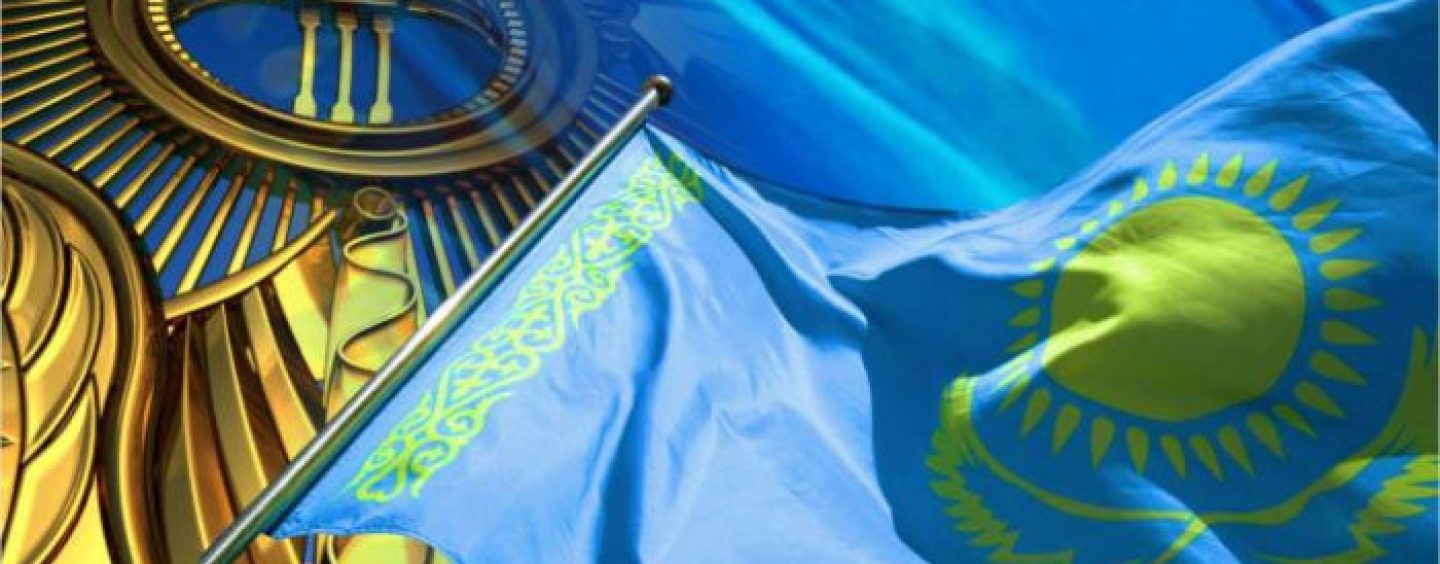
Kazakhstan New Geopolitics and Its Version of “New Silk Road” – “Bright Road” Strategy
By Daniel Szkarupski and Vakhtang Maisaia
The step landmass of today’s Kazakhstan was a home to nomadic people for a very long time, governed by numerous external forces, for example the empire of the Mongols, the Russian Empire and later on the Soviet Union these nomads were used to being ruled by others rather than to self-govern its territory. This unfortunate trend was broken after the collapse of the USSR when the Republic of Kazakhstan was proclaimed. Kazakh people had a little time to celebrate though as the new challenging times were before them. From the step nomads occupied only with agriculture Kazakh people had to take the role of the host of their own land in the new, unknown, world order that lied ahead.
Each state had to find its own place in the new design of the Eurasia space. For Kazakhstan the formal and planned beginning of this journey was year 1997 when a strategy Kazakhstan 2030 was introduced. Its main goals were to restore an order after the collapse of the Soviet system by transforming into the market economy, preparing an entirely new social system but most of all creating a new Nation in terms of so-called “Noosphere” (Near Sphere), a Nation free from the grasp of foreign influences which was bound to go its own way. This was a strategy outlined during the disturbing times following the downfall of the soviet empire. The most visible symbol of the present day Kazakhstan way to the future emerged in 2012 when the then president Nursultan Nazarbayev in his address to the Nation outlined the Strategy “Kazakhstan 2050” presenting a far-reaching and multidimensional strategy which was bound to guarantee that Kazakhstan will be a prosperous country in various spheres of political existence.
To very first idea which comes to a mind is the geopolitical position between two superpowers, Russia and China, and further a huge European market, this gave Kazakhstan a chance to take a role of the east – west corridor, a role they decided to take without any hesitation. Just two years after announcing Strategy 2050 the authorities published a “Нұрлы Жол” / Bright Path plan to stimulate its economy by modernizing the existing infrastructure and create new roads, railways, ports, airports and IT infrastructure. The estimated budget was nine billion dollars. The major reason behind this initiative was to link with One Belt, One Road programme especially when it comes to the railway modernization. The main aim of the Astana was to serve as a gateway to Europe for the People’s Republic of China. The goal of being a buckle for the One Belt One Road initiative can be marked as achieved, Kazakhstan used its favourable geographical situating to its advantage and it worked perfectly as the Bright Road programme was not just a wishful thinking. Both Kazakh and Chinese officials realized that route through Kazakhstan gives more security and stability than the alternative route through the Middle East, especially after the Arab Spring and the offensive of The Islamic State, which both make the region unstable till the the present, broke out. The circumstances were almost ideal for the Government in Astana and this ended up in a dynamic cooperation. Wave of international financing started floating to Kazakhstan from various institutions, for instance, Asian Development Bank, the European Bank for Reconstruction & Development (EBRD) and the Islamic Development Bank (IDB), the total number of projects carried out in Kazakhstan on 2020-10-05 reached 32. As it can be read in the outline published by the United States International Trade Administration the programme cover a variety of sectors including Architectural, Construction and Engineering Services, development of roads, railways and ports. What is particularly interesting is the case of airports as the number of such facilities with automated control systems is planned to rise from three to fifteen by the end of 2025. All this measures were implemented to strengthen the position of Kazakhstan as a main hub between the Asian space and European market. The first results are already visible in the official statistics of Bureau of National statistics of Kazakhstan, the number of operating railways dropped in 2011 to 14 892 kilometers, however in the following year it raised to 15 333 kilometers and was slowly but constantly increasing to the value of 16 635 km in 2019. The expansion of railway system connecting PRC and Republic of Kazakhstan is not slowing down even during the COVID pandemic as the new railway connecting China’s Guangxi Zhuang Autonomous Region with Nursultan was opened March 13, 2021.
With the development of infrastructure, the second strategical direction of expanding the trade by exporting should be an easy task, yet this was not a case in this particular area of development. According to statistics by the World Trade Organization there was a continuous growth in value of the export however since 2013 a constant drop can be observed, the decline ranged from 84,700 million dollars to 36,685 million dollars in 2016, a slight improvement occurred in the two-year period preceding the outbreak of COVID-19 to drop again when the pandemic started. This drop may put a strain on a formidably ambitious plan of the ex-president Nazarbayev, in his vision place Kazakhstan would be on the list of thirty most developed countries in the world in just thirty-eight years. The COVID -19 outbreak is bound to delay those plan as it had a deteriorating effect on both global and local economies alike.
Much stress was put on economics and building the welfare of Kazakh, however, this point was not the only goal set in the aforementioned document, politicians in Astana realized that after Bolsheviks imposed a Russian cultural code in their homeland a tactic to counter the effects of the Soviet Russia policy has to be implemented. The main effect of the USSR’s ulve over Eurasia was making a Russian language dominant in this region, changing this situation by 2025 was one of the milestones presented in the main document by Nazarbayev. The whole idea of restoring a national Kazakh diversity and tradition was directly named as creating a New Kazakhstan Patriotism. Despite the plan to adjust itself to the wide trend of globalization the government thrives in the concept of New Kazakhstan Patriotism based on non-communist origin till the present day.
Being a largest landlocked country beside Russia in what sir Halford Mackinder described as Heartland required a lot of intelligent and long distance planning, on one hand Kazakhstan was strongly connected with Russia through the seventy years of the Soviet dominance in that region, on the other, it faced being a fully independent country on the border of two pan-regions, that is, Russian and Japanese as the Haushofer presented it in his works although in the XXI century it should be called rather a China pan-region as the shift of political and cultural power occurred in this area. Putting a currently dominating political and cultural center of power aside, Kazakhstan quickly realized that isolation is not an option, just as the states in Central Europe realized full security depends on NATO and to some extent on the European Union the eastern people decided to join new international organizations of both military and civil nature such as the Commonwealth of Independent States, Collective Security Treaty Organization, Shanghai Cooperation Organization and the United Nations. Such a wide range of alliances clearly shows that the foreign policy of the Kazakh’s state is based on multilateral relations.
A quick look at the map and yet another important issue can be observed, the geographical position is crucial not only in trade but also in defence, Kazakhstan position on the map makes it buffer zone between Russia and regions which show an instability in comparison to the Kazakh’s state. Losing such a “soft underbelly” as Churchill called similar phenomena in Europe would open a way for a potentially hostile forces to both European and West Siberian Plains, such a threat combined with growing tension with NATO alliance would shake the entire Russian defensive system grounded in favourable geography which saved Soviets during World War Two when they evacuated their industry behind the immense wall of the Ural Mountains. This gives the Kazakhstan authorities a leverage on Russia as they may be crucial to many major players in the world.
With the initial success of the Bright Road strategy in the field of infrastructure and not having too much of a success in the field of export, the government in Nur-Sultan decided it will not only serve as a hub between bigger players but also it has to build its own regional power. Allowing foreign investors to enter their market resulted in taking yet another step in ensuring a growth of the Kazakh’s economy as well as its attachment to the global supply chains, a perfect example of such a cooperation occurred on March 26, 2021 when a factory of KIA was opened in Kustanay in the presence of the then Prime Minister Askar Mamin, thanks to this factory and cooperation between KIA and KAMAZ PTC the government is showing the realization of their grand strategy in practice as the increase of welfare and industrial development are considered one of the key branches of the “Kazakhstan 2050” and “Нұрлы Жол” strategies.
Encouraging big, international capital to invest in Kazakhstan was one of the steps to boost its economy, however, the government set out a special position for small and medium-sized enterprises, the strategy assumed that those will constitute 50 % of GDP till 2021, as it could be observed this part of the strategy was not achieved as planned, the increase of small and medium sized companies is visible, as it moved form 10,5 percent in 2005 to nearly 32 percent in 2019 showing that the Kazakh Government takes the realization of the Nazarbayev’ s plan with a great dose of persistence even as the pandemic continues. The recent meeting of the state Commission of Economic Growth clearly indicates that the state is going to continue the strategy to aid the native companies survive by deferring tax, bank loans and microcredits payments during the Covid 19 crisis in order to help the native economy get back on track after the virus is contained in the region.
Implemented strategy and programmes bound to carry it out were originally oriented to the east and west, nevertheless, they may not be the only directions which Nur-Sultan is having in mind, recent visit of Roman Sklyar at XVI meeting of Intergovernmental Kazakh-Tajik Commission on Economic Cooperation clearly indicated that the cooperation between Kazakhstan and its smaller neighbors is to be maintained and developed, it is obvious that in the minds of Astana’s decision makers it is their country that will play a leading role as a regional power. Going even further, Kazakhstan authorities turn their eyes into the Middle East, no strategic document concerning this vector of expansion was released, and however, the recent visit to United Arab Emirates may indicate that Kazakhstan is planning to expand in the axis south – north as well. In addition to existing geopolitical position of Kazakhstan a new potential way of advancing is likely to occupy the thoughts of politicians in the Eurasia, including Mamin’s Government, namely the Northern Sea Route which is strongly advertised by Russia, opening a new sea route is something that has not happened on such a scale since the great geographical discoveries of XV and XVI centuries. The recent incident in the Suez Canal served as a trigger to yet another wave of promoting this new, cold sea road as an ideal alternative for sea routes widely used in the XXI century.
To summarize all of the above, both the “Strategy 2050” and “Bright Road” initiative proved to be a well-designed document which evaluated the geopolitical potential properly and outlined the directions in which the new, independent Kazakhstan, should proceed in the XXI century. It cannot be denied that certain aspects of the plan were not achieved, nevertheless, the persistence combined with the ability to adjust to the dynamically changing circumstances occurring in the Eurasian space paved the way for the Kazakhstan to be a self-governed regional player which uses its geopolitical advantages in a variety of the spheres of the country’s current political existence and further development.





